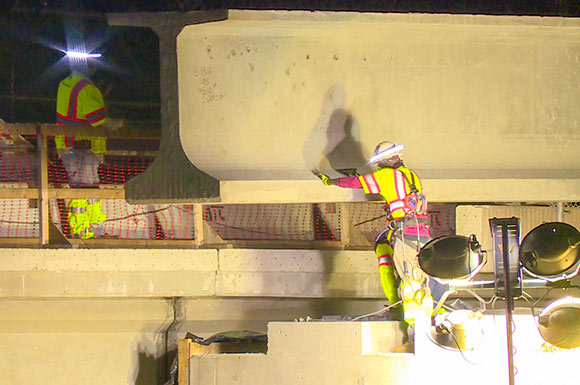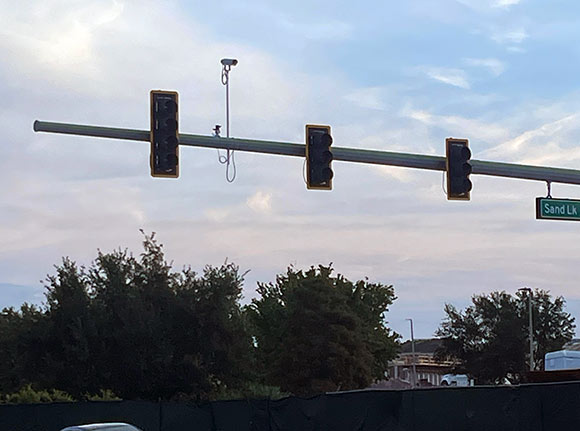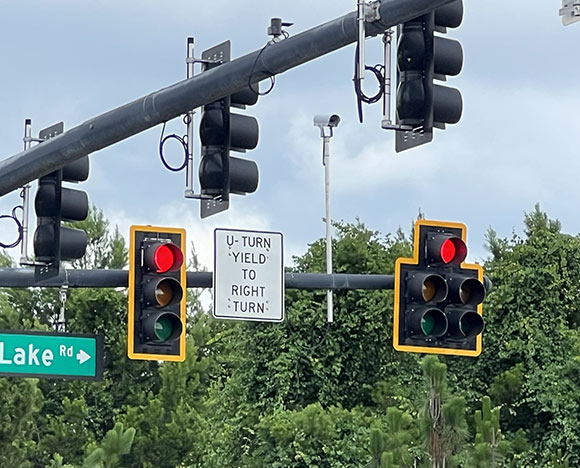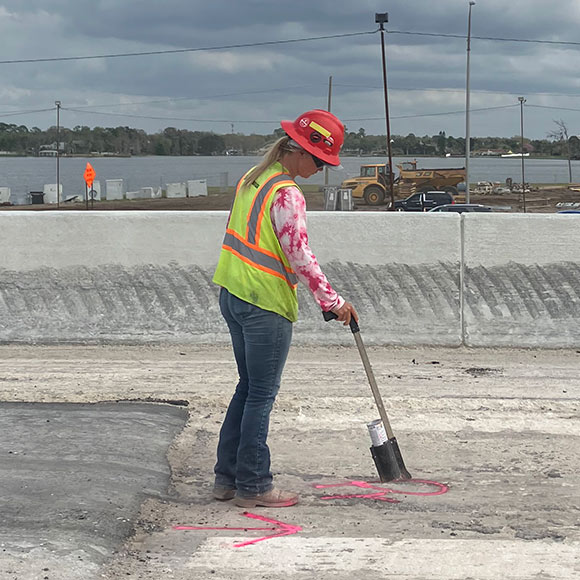Beam Setting a Crucial Step in Building New Sand Lake Road Loop Ramp
Beam setting is a crucial process in bridge construction, involving the placement and alignment of the structural elements that support the bridge deck. The process includes preparing the construction site and transporting, positioning, and securing massive beams.
Preparing the construction site involves clearing obstacles and reinforcing the foundation to ensure it can support the weight of the beams. Temporary support may be set up to aid in the positioning process.
Once the site is ready, the beams for the bridge are transported from the manufacturing site to the construction site. This process often requires specialized equipment due to the beams’ size and weight. Careful planning is essential to minimize risks during transport.
Next, cranes and other heavy lifting equipment are used to position the beams onto the bridge. This step requires precision to align the beams according to the design specifications. Proper alignment ensures the beams are level and correctly oriented to support the bridge deck.
Finally, the beams are secured to maintain their alignment and structural integrity. This can involve bolting, welding, or encasing them in concrete, depending on the design and materials used. Ensuring the beams are firmly fixed prevents movement and maintains stability under load.
Beam setting will be an important step in the construction of the new loop ramp that will connect Sand Lake Road (State Road 482) and Turkey Lake Road. The new ramp will eliminate the current left turn from westbound Sand Lake Road to southbound Turkey Lake Road, improving traffic flow at the interchange. Motorists will also be able to exit westbound Interstate 4 (I-4) either to Sand Lake Road or directly to Turkey Lake Road when the project is completed.
To learn more about the Sand Lake Road and I-4 interchange project, visit i4beyond.com/SandLake.
|
|
Diverging Diamond Interchanges:
What Happens When the Lights Go Out?
Technology has created wonderful things that can make our lives easier and more manageable. We use technology to simplify complex situations, just as traffic signals help keep intersections organized and improve safety. A set of colored lights tells motorists when to go and when to stop — not only making the roadways safer, but also more efficient.
Traffic signals are effective at managing conventional interchanges and diverging diamond interchanges (DDIs). Unlike a conventional interchange, the lanes in a DDI cross over to the left side of the roadway, allowing motorists to make left turns without crossing in front of oncoming traffic. The lanes then change back to the right side of the road at a second traffic signal. These motions would be challenging without the assistance of traffic signals.
But what happens when something goes wrong? The Florida Department of Transportation (FDOT) has simple solutions in place to ensure motorists will not be left in the dark.
Many people know that if a traffic signal loses power, motorists should treat a standard intersection as a four-way stop. But what if it happens at a DDI? It is understandable that drivers might have concerns when faced with unusual conditions, especially in the midst of an unfamiliar traffic pattern, such as the new DDIs along Interstate 4 (I-4).
When an intersection loses power, FDOT sends notifications to the public, requesting motorists seek alternate routes. The Department urges motorists to exercise heightened caution when proceeding through an intersection during outage periods and to be observant of any law enforcement or construction workers at the site.
FDOT has on-site battery backup systems in place to provide power at Central Florida DDIs. In the event of an extended outage, or if a battery backup system fails, crews will immediately deploy generators to deliver power. Law enforcement will also respond quickly to direct traffic during the outage period.
If motorists approach a DDI when signals are not working and law enforcement is not yet present, they should proceed with caution through the interchange, treating nonworking lights as stop signs, much as they would at the intersection of two one-way streets.
First, motorists should stop at all traffic signals, proceeding only when traffic in the other direction is clear. Motorists approaching from different directions should take turns as they would at a two-way stop. When entering the DDI from interstate exit ramps, motorists should stop at the signal and only proceed when the roadway is clear. Once power is restored, the interchange will return to normal operation.
To learn more about DDIs, visit this DDI toolkit.
|
|
August 4-10 Is Stop on Red Week
Red light, green light. Stop and go. It’s a concept so ingrained in most Americans that a popular children’s game is based on it. As such, one might think it wouldn’t be necessary to spend a week reminding people to stop on red. After all, everyone learned the significance of signal colors as children, right?
Unfortunately, according to the American Automobile Association (AAA), almost one in three drivers admitted to running a red light within the previous month before taking the organization’s survey.
With so many drivers not treating red lights as seriously as they should, it should be no surprise that crashes due to red light running have been rising for the past 10 years. A study by the Insurance Institute for Highway Safety found that 1,149 people were killed in crashes involving a driver running a red light in 2022. Over 100,000 were injured, according to the study, with half being victims of the motorist who failed to stop. In all, red light running caused 28% of all crashes in intersections during that year.
The Florida Department of Transportation (FDOT) recognizes August 4-10 as National Stop on Red Week. This event marks a good time for motorists to remember the lessons learned in their youth and stop at red lights every time they encounter one.
Many intersections allow motorists to turn right on red. It is important to remember that this is not a green light to make right turns. Motorists approaching a red light are allowed to turn right only after coming to a stop at the light and making sure the area is clear of other vehicles, pedestrians, and cyclists. Turning right without stopping is the same thing as running the light, and violators can be ticketed, even if they don’t cause a crash.
All motorists should be aware that while making a right turn at a red light, they do not have the right of way, and they must yield to drivers with a green light — even those turning left or making U-turns (unless otherwise signed at that intersection). Safe drivers will remember to make a complete stop.
Running red lights is easily preventable. If everyone remembers to stop on red it could save 1,000 lives each year. During Stop on Red Week, and every week, please recall the games of youth. Green light…red light.
|
|
Employee Spotlight: Samantha Stanley, Grade Crew Operator
Construction crews continue to make progress on the Interstate 4 (I-4) and Daryl Carter Parkway interchange project as part of I-4 Beyond the Ultimate improvements in Central Florida. Teams of hard-working, focused individuals make up the crews who take on the challenges of these projects.
Samantha Stanley, a grade crew operator on the Daryl Carter Parkway project, uses her skills to meaningfully contribute to the project. The grade crew moves sand or dirt to shape the land within the construction site that the road is built on. The grade, which refers to the reshaped earth, is then topped off with lime rock and asphalt. Once the asphalt is paved and striped, it is ready for vehicular traffic.
“I work on the roadway crew, so without me finishing my job, there’s no road to be driven on,” she said. “Our process is basically the last step.”
Samantha’s interest in construction developed from watching her father work in the field, and by the time she finished high school, she knew where she wanted to be.
“My dad has done construction my whole life, so it started with him when I came out of high school,” Samantha said. “I knew I could progress and be up higher on the chain.”
She started as a laborer and quickly mastered the skills needed to advance in her career. She has worked in construction for five years, pausing her career for a time to raise her son. In that time, she progressed to a grade crew operator — a position that requires steady and precise planning.
Using GPS equipment, Samantha helps collect data to prepare the grade for lime rock and asphalt. This crucial step ensures the construction site is set properly for drainage and roadway foundation. Samantha’s proficiency in this area comes from her eagerness to learn each time she comes to work. She said one of the things she likes about her job is that each day is different.
“Now that I’m able to operate equipment and know the process, I feel like every day you learn something new,” Samantha said.
On such a large project, Samantha said it’s important to speak up when something seems off. As a roller, she gets a strong sense of what direction the grade is going and knows where lime rock can be placed. The team, she said, will improve by communicating issues so they don’t have to repeat any steps.
“The best advice I can give is you don’t butt heads,” she said. “If you see something, you say something. If you think something is wrong, don’t be afraid to say anything.”
As the project continues, Samantha said she’d like to move up to a load operator role, taking on more responsibilities along the way. She’s not afraid of challenges and knows what it takes to overcome them.
For more information on the I-4 and Daryl Carter Parkway project, visit the Daryl Carter Parkway project page.
|
|
|






